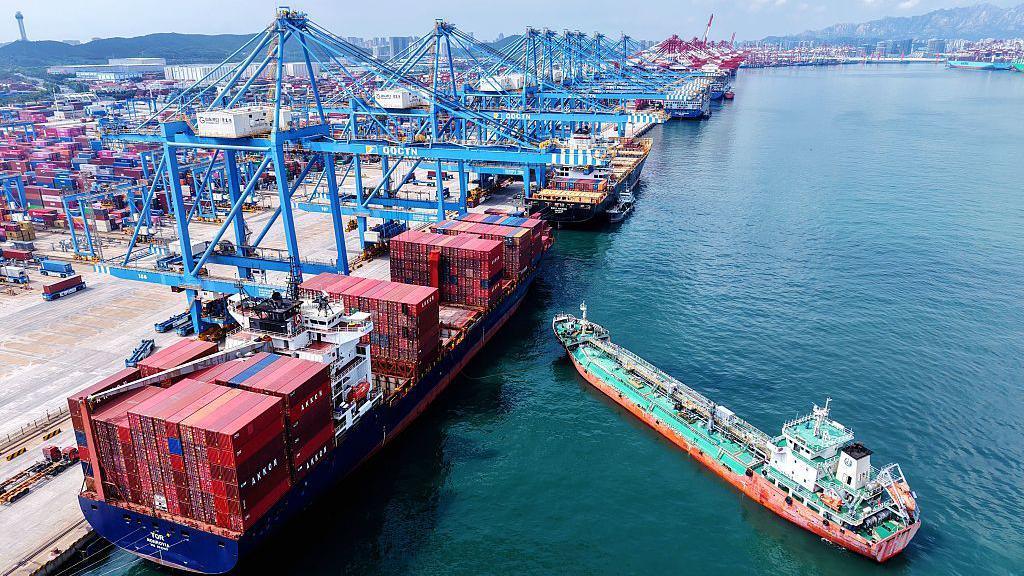US and China extend trade truce to avoid tariffs hike

- Published
The US and China have extended their trade truce for another 90 days, just hours before the world's two biggest economies were set to raise tariffs on imports of each other's goods.
On Monday, US President Donald Trump signed an executive order, external to keep the pause in place until 10 November, while Beijing also announced an extension.
It means the US will hold its levy on Chinese imports at 30%, while China will keep a 10% tariff on American goods.
Washington had threatened trade taxes as high as 145% on Chinese products earlier this year, with Beijing hitting back with 125% duties on US shipments. The rates for both countries were scaled back after a round of trade talks held in Geneva in May.
The latest extension will give more time for further negotiations about "remedying trade imbalances" and "unfair trade practices", the White House said.
It cited a trade deficit of nearly $300bn (£223bn) with China in 2024 - the largest among any of its trading partner.
The talks will also aim to increase access for US exporters to China and address national security and economic issues, the statement said.
A spokesperson for the Chinese embassy in Washington said: "Win-win cooperation between China and the United States is the right path; suppression and containment will lead nowhere."
China also called on the US to lift its "unreasonable" trade restrictions, work together to benefit companies on both sides and maintain the stability of global semiconductor production.
Tariffs - taxes charged on goods bought from other countries that are typically a percentage of a product's value - have been a key focus of Trump since he returned to the White House in January.
He has repeatedly said tariffs will encourage US consumers to buy more American-made goods, increase the amount of tax raised and boost investment.
Referring to his trading partners around the world, the US presiden has argued that his country has been taken advantage of by "cheaters", and "pillaged" by foreigners.
What tariffs has Trump announced and why?
- Published5 November
A return of higher duties would have risked further trade turmoil and uncertainty amid worries about the effect of tariffs on prices and the economy.
But one US business owner told BBC Radio 4's Today programme that the extension just meant further uncertainty.
"There's no way to plan for the future of the business," said Beth Benike, founder of Busy Baby.
"Since I have no idea what the tariff is actually going to end up being I have no control or idea about the pricing that's going to work for my business," she said.
Tensions between the US and China reached fever pitch in April, after Trump unveiled sweeping new tariffs on goods from countries around the world, with China facing some of the highest levies.
Beijing retaliated with tariffs of its own, sparking a tit-for-tat fight that saw tariffs soar into the triple digits and nearly shut down trade between the two countries.
The two sides had agreed to set aside some of those measures in May.
That agreement left Chinese goods entering the US facing an additional 30% tariff compared with the start of the year, with US goods facing a new 10% tariff in China.
The two sides remain in discussions about issues including access to China's rare earths, its purchases of Russian oil, and US curbs on sales of advanced technology, including chips to China.
Trump recently relaxed some of those export restrictions, allowing firms such as AMD and Nvidia to resume sales of certain chips to firms in China in exchange for sharing 15% of their revenues with the US government.
That "unprecedented" agreement has provoked criticism, with some calling it a "shakedown".
The US is also pushing for the spin-off of TikTok from its Chinese owner ByteDance, a move that has been opposed by Beijing.
Earlier on Monday in remarks to reporters, Trump did not commit to extending the truce but said dealings had been going "nicely". A day earlier he called on Beijing to increase its purchases of US soybeans.
Even with the pause, trade flows between the countries have been hit this year, with US government figures, external showing US imports of Chinese goods in June cut nearly in half compared with June 2024.
In the first six months of the year, the US imported $165bn worth of goods from China, down by about 15% from the same time last year.
American exports to China fell roughly 20% year-on-year for the same period.
Get in touch
How are you or your business affected by tariffs? What questions do you have?

Follow the twists and turns of Trump's second term with North America correspondent Anthony Zurcher's weekly US Politics Unspun newsletter. Readers in the UK can sign up here. Those outside the UK can sign up here.